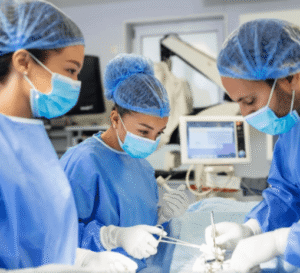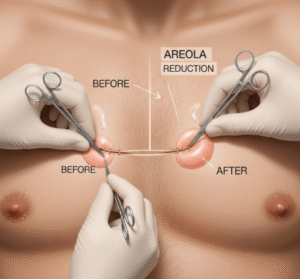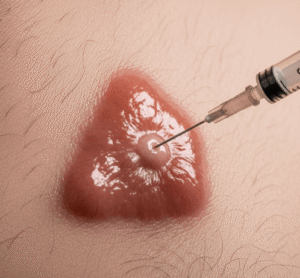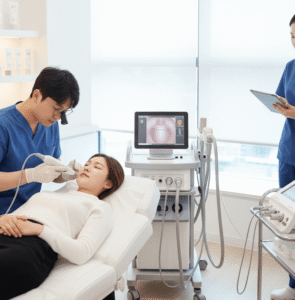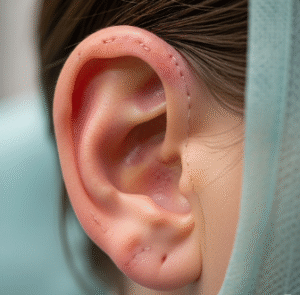Overview
Jaw implant surgery is a cosmetic and reconstructive procedure designed to enhance the shape, size, and contour of the jawline and chin. It is performed using biocompatible implants to achieve balanced facial proportions, stronger jaw definition, and improved facial aesthetics.
South Korea is renowned for advanced facial plastic surgery, highly skilled maxillofacial surgeons, and cutting-edge implant techniques, making it a top destination for patients seeking safe, natural-looking jaw augmentation with minimal complications.
What is Jaw Implant Surgery?
Jaw implant surgery involves:
- Placement of synthetic or biocompatible implants along the jawline or chin
- Enhancement of facial symmetry and aesthetics
- Reconstruction for congenital defects, trauma, or asymmetry
Indications for jaw implant surgery include:
- Weak or recessed chin or jawline
- Facial asymmetry or deformity
- Age-related jawbone resorption
- Desire for aesthetic improvement or stronger facial profile
Materials used:
- Silicone, Medpor (porous polyethylene), or custom 3D-printed implants
- Implants are designed to integrate safely with facial tissues
What are the Benefits?
- Improved facial balance and aesthetics → Sharper jawline and chin definition
- Enhanced confidence and self-image → Positive impact on social and professional life
- Permanent or long-lasting results → Implants remain in place with proper care
- Minimally invasive techniques → Small incisions with reduced scarring
- Customizable results → Size, shape, and contour tailored to the patient
- Expert care in Korea → Precision surgery for natural outcomes
Procedure Details
1) How should I prepare for jaw implant surgery?
- Preoperative evaluation → Facial imaging, CT scans, and medical assessment
- Medication guidance → Avoid blood thinners or anti-inflammatory drugs prior to surgery
- Lifestyle preparation → Stop smoking and alcohol; maintain good oral hygiene
- Pre-procedure consultation → Discuss implant type, expected results, anesthesia, and post-operative care
- Psychological preparation → Understand realistic outcomes and recovery expectations
2) What happens during the procedure?
- Anesthesia → General anesthesia or local anesthesia with sedation
- Patient positioning → Supine with head stabilized
- Surgical steps →
- Small incisions made inside the mouth or under the chin
- Jaw and chin area exposed carefully to create a pocket for implant
- Implant inserted and positioned to enhance jaw contour
- Incisions closed with absorbable sutures; careful alignment confirmed
- Duration → 1–2 hours depending on complexity
- Monitoring → Vital signs monitored continuously; precision placement ensured
3) What happens after surgery?
- Immediate post-operative care → Observation for swelling, bruising, or discomfort
- Pain management → Analgesics and cold compresses for swelling reduction
- Dietary recommendations → Soft or liquid diet for first few days
- Activity restrictions → Avoid strenuous activity, facial trauma, or heavy lifting for 2–3 weeks
- Follow-up visits → Incision healing assessment, implant position monitoring, and suture removal if needed
Risks / Benefits
Risks
- ➤ Infection at incision site
- ➤ Swelling, bruising, or temporary numbness
- ➤ Implant displacement or asymmetry
- ➤ Scarring (minimal with intraoral incision)
- ➤ Rare reaction to anesthesia or implant material
Benefits
- ➤ Enhanced facial aesthetics and symmetry
- ➤ Permanent or long-lasting jawline improvement
- ➤ Minimally invasive with precise placement
- ➤ High satisfaction rates under expert Korean surgeons
- ➤ Improved confidence and natural facial balance
Recovery and Outlook
- Immediate recovery → Swelling and mild discomfort for 1–2 weeks
- Short-term follow-up → 1–2 weeks to monitor healing and incision closure
- Return to normal activity → Most daily activities within 1 week; strenuous activity after 2–3 weeks
- Long-term outlook → Permanent enhancement with proper care; natural integration of implant
- Post-procedure care → Avoid trauma, maintain oral hygiene, follow diet recommendations, and attend scheduled check-ups
- Expected results → Sharper jawline, balanced facial profile, and increased confidence
South Korea provides comprehensive post-operative care, precision surgery, and follow-up services to ensure safe, effective, and aesthetically pleasing outcomes.
When To Call the Doctor
Contact your surgeon immediately if you notice:
- ⚠️ Severe swelling, redness, or discharge at the incision site
- ⚠️ Persistent or worsening pain not relieved by medications
- ⚠️ Implant shifting or asymmetry
- ⚠️ Fever or signs of infection
- ⚠️ Numbness or tingling that does not improve over time
Best Korea Option / Process
South Korea is a leading destination for jaw implant surgery due to:
- Expert maxillofacial and cosmetic surgeons
- Advanced surgical techniques with minimally invasive approach
- Custom implant design and 3D imaging
- Comprehensive post-operative care and patient education
- International patient services → Consultation, translation, scheduling, and follow-up
Top Hospitals for Jaw Implant Surgery in Korea:
- JK Plastic Surgery Center, Seoul – Expert facial contouring and jawline surgery
- Banobagi Plastic Surgery, Seoul – Advanced cosmetic jaw and chin augmentation
- BK Plastic Surgery Center – Precision jaw implant placement and post-op care
- Grand Plastic Surgery, Seoul – Custom 3D jaw implants and aesthetic facial surgery
👉 For patients seeking a well-defined, aesthetically balanced jawline, jaw implant surgery in Korea offers expert, safe, and long-lasting results with personalized care.



